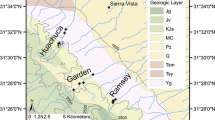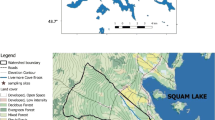Abstract
Calcite treatment of chronically acidic lakes has improved fish habitat, but the effects on downstream water quality have not previously been examined. In this study, the spatial and temporal effects of watershed CaCO3 treatment on the chemistry of a lake outlet stream in the Adirondack Mountains of New York were examined. Before CaCO3 treatment, the stream was chronically acidic. During spring snowmelt before treatment, pH and acid-neutralizing capacity (ANC) in the outlet stream declined, and NO −3 and inorganic monomeric aluminum (AlIM) concentrations increased sharply. During that summer, SO −4 and NO −3 concentrations decreased downstream, and dissolved organic carbon (DOC) concentrations and ANC increased, in association with the seasonal increase in decomposition of organic matter and the attendant SO −4 -reduction process. A charge-balance ANC calculation closely matched measured downstream changes in ANC in the summer and indicated that SO −4 reduction was the major process contributing to summer increases in ANC. Increases in Ca2+ concentration and ANC began immediately after CaCO3 application, and within 3 months, exceeded their pretreatment values by more than 130 μeq/L. Within 2 months after treatment, downstream decreases in Ca2+ concentration, ANC, and pH, were noted. Stream mass balances between the lake and the sampling site 1.5 km downstream revealed that the transport of all chemical constituents was dominated by conservative mixing with tributaries and ground water; however, non-conservative processes resulted in significant Ca2+ losses during the 13-month period after CaCO3 treatment. Comparison of substrate samples from the buffered outlet stream with those from its untreated tributaries showed that the percentage of cation-exchange sites occupied by Ca2+ as well as non-exchangeable Ca, were higher in the outlet-stream substrate than in tributary-stream substrate. Mass-balance data for Ca2+ H+, AlIM, and DOC revealed net downstream losses of these constituents and indicated that a reasonable set of hypothesized reactions involving AlIM, HCO −3 , Ca2+, SO −4 NO −3 , and DOC could have caused the measured changes in stream acid/base chemistry. In the summer, the sharp decrease in ANC continued despite significant downstream decreases in SO4 2− concentrations. After CaCO3 treatment, reduction of SO −4 was only a minor contributor to ANC changes relative to those caused by Ca2+ dilution from acidic tributaries and acidic ground water, and Ca2+ interactions with stream substrate.
Similar content being viewed by others
References
Asbury CE, Vertucci FA, Mattson MD & Likens GE (1989) Acidification of Adirondack lakes. Environ. Sci. Technol. 23: 362–365
Baker JP & Christensen SW (1991) Effects of acidification on biological communities in aquatic ecosystems. In: Charles DF
Baker LA, Herlihy AT, Kaufmann PR & Eilers JM (1991) Acidic lakes and streams in the United States: The role of acidic deposition. Science. 252: 1151–1154
Bengtsson B, Dickson W & Nyberg P (1980) Liming acid lakes in Sweden. Ambio. 9: 34–36
Black CA, Evans DD, White JL, Ensminger LE & Clark FE (Eds) (1965) Methods of Soil Analysis. Part 2 — Chemical and Microbiological Properties. Amer. Soc. Agron. Monograph 9. Madison, Wisconsin
Booth GM, Hamilton JG & Molot LA (1986) Liming in Ontario: Short-term biological and chemical changes. Water Air Soil Pollut. 31: 709–720
Cirmo CP & Driscoll CT (1993) Beaver pond biogeochemistry: acid neutralizing capacity generation in a headwater wetland. Wetlands. 13: 277–292
Cirmo CP & Driscoll CT (1996) The role of a beaver impoundment in regulating stream chemistry after a watershed calcium carbonate treatment. Biogeochemistry 32: 265–297 (this issue)
Dillon PJ, Reid RA & de Grosbois E (1987) The rate of acidification of aquatic ecosystems in Ontario, Canada. Nature. 329: 45–48
Driscoll CT & Newton RM (1985) Chemical characteristics of Adirondack lakes. Environ. Sci. Technol. 19: 1018–1024
Driscoll CT, Baker JP, Bisogni JJ & Schofield CL (1984) Aluminum speciation and equilibria in dilute surface waters of the Adirondack region of New York State. In: Bricker OP
Driscoll CT, Wyskowski BJ, Cosentini CC & Smith ME (1987) Processes regulating temporal and longitudinal variations in the chemistry of a low-order woodland stream in the Adirondack region of New York. Biogeochemistry 3: 225–241
Driscoll CT, Ayling WA, Fordham GF & Oliver LM (1989) Chemical response of lakes treated with CaCO3 to reacidification. Can. J. Fish. Aquat. Sci. 46: 258–267
Driscoll CT, Lehtinen MD & Sullivan TJ (1994) Modeling the acid-base chemistry of organic solutes in Adirondack, New York, lakes. Water Resour. Res. 30: 297–306
Driscoll CT, Cirmo CP, Fahey TJ, Blette VL, Burns DA, Gubala CP, Newton RM, Raynal DJ, Schofield CL, Yavitt JB & Porcella DB (1996) The Experimental Watershed Liming Study (EWLS): comparison of lake/watershed base neutralization strategies. Biogeochemistry 32: 143–174 (this issue)
Gran G (1952) Determination of the equivalence point in potentiometric titrations. Int. Congr. Anal. Chem. 77: 661–671
Gubala CP, Driscoll CT, Newton RM & Schofield CL (1991) Chemistry of a near-shore lake region during spring snowmelt. Environ. Sci. Technol. 25: 2024–2030
Hemond HF (1990) Acid neutralizing capacity, alkalinity, and acid-base status of natural waters containing organic acids. Environ. Sci. Technol. 24: 1486–1489
Henriksen A & Seip HM (1980) Strong and weak acids in surface waters of southern Norway and southwest Scotland. Water Res. 14: 809–813
Hultberg H & Andersson IB (1982) Liming of acidified lakes: Induced long-term changes. Water Air Soil Pollut. 18: 311–331
Johnson AH (1979) Estimating solute transport in streams from grab samples. Water Resour. Res. 15: 1224–1228
Kretser W & Colquhon J (1984) Treatment of New York"s Adirondack lakes by liming. Fisheries. 9: 36–41
Munson RL & Gherini SA (1993) Influence of organic acids on the pH and acid-neutralizing capacity of Adirondack Lakes. Water Resour. Res. 29: 891–899
Perdue EM (1985) Acidic functional groups of humic substances. In: Aiken GR Etal w York
Peters NE & Murdoch PS (1985) Hydrogeologic comparison of an acidic-lake basin with a neutral-lake basin in the west-central Adirondack Mountains, New York. Water Air Soil Pollut. 26: 387–402
Schaefer DA, Driscoll CT, Van Dreason R & Yatsko CP (1990) The episodic acidification of Adirondack lakes during snowmelt. Water Resour. Res. 26: 1639–1647
Schecher WD & Driscoll CT (1987) An evaluation of uncertainty associated with aluminum equilibrium calculations. Water Resour. Res. 23: 525–534
Schofield CL, Galloway JN & Hendry GR (1985) Surface water chemistry in the ILWAS basins. Water Air Soil Pollut. 26: 403–423
Theobald PK, Lakin HW & Hawkins DB (1963) The precipitation of aluminum, iron, and manganese at the junction of Deer Creek with the Snake River in Summit County, Colorado. Geochim. Cosmochim. Acta. 27: 121–132
Wright RF & Skogheim OK (1983) Aluminum speciation at the interface of an acid stream and a limed lake. Vatten. 39: 301–304
Author information
Authors and Affiliations
Rights and permissions
About this article
Cite this article
Burns, D.A. The effects of liming an Adirondack lake watershed on downstream water chemistry. Biogeochemistry 32, 339–362 (1996). https://doi.org/10.1007/BF02187145
Received:
Accepted:
Issue Date:
DOI: https://doi.org/10.1007/BF02187145




